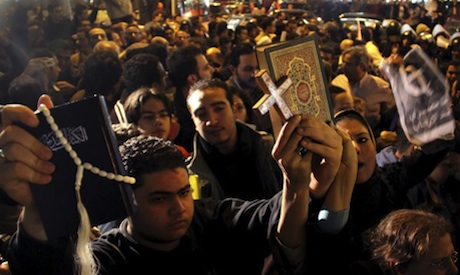Call it involuntary distance education. But it all worked out for the best.
This morning I woke to the biggest heaviest snowfall I have seen in a long time. I have a very long country driveway that can be cleared by hand if the time is available, or plowed if our neighbor is available. Looking out the window I knew that handscraping was not going to be possible. Certainly not before my 10 o'clock class. My three-hour seminar starting at 12:30? That would depend upon my neighbor.
By 11 o'clock it was pretty clear that he was not going to show up in time. (It turns out that he was having tractor trouble.) What to do? Cancel another class? That thought really bugged me. This was the last class before our in-class midterm, and there were things I wanted to get done.
One faint possibility occurred to me. What if I used Skype to communicate with the students? It might not be an ideal way to run a seminar discussion, but surely it would be better than an unplanned disruption. I called the IT helpdesk. Could they set up a computer in the classroom to be a Skype station? Would they?
No hesitation. I am sure they had plenty of other things to do, but with great willingness and competence they set up my classroom so that I could discuss the upcoming term test and run a discussion on queens and other wives in sixth-century France. I would not have you think it was perfect, but it was better than the alternative: sitting in front of the fire with a glass of wine… Wait a minute, was that a possibility?
I was glad in any case not to lose the class meeting. Thanks, Marg! Thanks, Greg! Thanks, whoever else pitched in (that includes at least one student)!
Sometimes this really is a great place to work.
Image: hmm...
Ancient, medieval, Islamic and world history -- comments, resources and discussion.
Wednesday, November 30, 2011
IT heroes save the day at Nipissing University
Labels:
computers,
Nipissing University,
teaching
Jimi Hendrix would have been 69 this month
That little laugh he used for punctuation says so much.
Tuesday, November 29, 2011
Writing errors that make you look dumb
I don't know if any of my current students read this blog, but any who do might consider that I think this article is right on the money!
Labels:
writing
Monday, November 28, 2011
Get out the vote!
The Arabist on today's Egyptian elections. Enthusiasm?
Labels:
Arab Spring,
Egypt,
history of democracy
Saturday, November 26, 2011
Digging the lost harbor of Theodosius
This week the CBC TV show The Nature of Things had an episode on the discovery and archaeological rescue of one of the major harbors of Constantinople. I missed it, but fortunately the whole episode is on the web.
The reason that this harbor was found was the construction of a train tunnel across the Bosphorus. Both the construction of the tunnel and the archaeological rescue are technological wonders. This is a technological nerd-fest.
And the photography of Istanbul is great, too.
Did I mention that they found 37 medieval ships?
Image: rescue archaeology.
The reason that this harbor was found was the construction of a train tunnel across the Bosphorus. Both the construction of the tunnel and the archaeological rescue are technological wonders. This is a technological nerd-fest.
And the photography of Istanbul is great, too.
Did I mention that they found 37 medieval ships?
Image: rescue archaeology.
Labels:
archaeology,
Istanbul,
ships
Friday, November 25, 2011
Thanks to my audience
In North Bay, Ontario, you can fill a room late Friday afternoon, late in dreary November, with faculty members, students, non-university community members and a dean or two, to listen to a paper on the fears and insecurities of 14th century men-at-arms.
Who knew?
Thanks for coming, people.
Image: Someone else's seminar, in Hong Kong. They had a bigger audience.
Who knew?
Thanks for coming, people.
Image: Someone else's seminar, in Hong Kong. They had a bigger audience.
Thursday, November 24, 2011
Newt Gingrich, the Republican candidate with the history PhD, analyzes our current troubles
As summarized by Jim Wright:
Apparently, according to Newt, America’s current economic woes stem from two sources: greedy middle school janitors and unemployed children.There's more, and all of it equally on target.
Newt’s solution? Fire the janitors, hire the kids.
Like chocolate and peanut butter, or feeding the homeless to the hungry, kids and janitorial work naturally go together. It’s just so, so obvious when Newt points it out, isn’t it?
Fire the janitors, hire the kids.
Brilliant.
First we recoup billions in janitor salaries.
Those goddamned janitors and their outrageous salaries. Who can forget those greedy maintenance men commuting to school each morning? Their private helicopters landing on the roof of the gymnasium, flying in from the Hamptons after a weekend of booze, blow and hookers? Their chauffer driven limos blocking the school bus loading zones? Oh yes, let us never forget who caused this financial disaster, them with their 24K gold handled mops and gilded toilet plungers while our children could barely afford to chew gum and stick it to the bathroom mirrors? I tell you, nothing chaps my ass more than when those key-twirling broom jockeys took billions in taxpayer bailouts and then gave themselves millions in bonuses. Personally I think it’s a Goddamned outrage that they get taxpayer funded lifetime pensions and golden parachutes even after being found guilty of ethics violations and forced to resign from their jobs. Honest to God, folks, how many more countries could we have invaded if these jumpsuit wearing sons of bitches weren’t bleeding us dry? How many more faith based programs could we have funded? How many high school girls had to graduate because those damned janitors stole money for abstinence only birth control classes? How many aircraft carriers could we have built? Ask yourself this, how many more tenured history professors could we have hired if we hadn’t had to pay those stinkin’ greedy Janitors? Hell, we could have filet mignon and caviar in the Congressional lunchroom three meals per day instead of, well, ok bad example, but I think I’ve made my point here.
P.s. When was the last time you heard someone in the public forum speak up for more tenured history professors? Oh, I know it's satire, but even still...
Monday, November 21, 2011
Sunday, November 20, 2011
Smarter protest, please
Phil Paine, continuing this earlier post:
Image: Boycotting the segregated bus system, 1955
Shakespeare didn’t have Romeo and Juliet commit suicide in the first act, and then let the remaining characters pitch tents on the stage and chat aimlessly for the remaining four acts. That was because Shakespeare was a dramatist. His aim was to move people to emotion, to make them think, to shock, horrify, or delight them. Let us, for the sake of argument, assume that he was pretty good at it. Today’s protesters could learn a thing or two from him.Read the whole thing.
As I mentioned in Part 1, the Occupy protest movement began by taking advantage of new methods (the social media), and then quickly reverted to an old formula. The advantage that social media offered was the ability to bring people together quickly to do some strategic and dramatic thing —- to surprise. The “flash mob” is the appropriate template for a protest using social media. The flash mob originated as an amusement —- one in Toronto called people to a pillow fight in front of the Eaton Centre. There have been some political protests using this technique, and these have been dubbed “smart mobs,” but their use has been very limited, so far. The key to the flash mob’s effectiveness is its ability to end as dramatically as it begins. This leaves those in authority disconcerted, and makes them look incompetent. It has the same advantage in protest that guerilla tactics can have in military conflicts.
The Occupy movement has squandered the opportunity to move into the modern age of protest. Social media were used to bring people together, but once there, power reverted to the traditionalists, and the only thing they could think of doing was squatting down and staying put. The smart mob turned into a “sit in,” a protest relic from a generation ago that is notorious for its ineffectiveness and tendency to alienate the very people that the protest is supposed to convince.
...
If you speak to these old-schoolers, it won’t be long before you hear them prattle nonsense about how they are continuing the traditions of the Civil Rights Movement in the 1950’s and 1960’s. They are deluding themselves. The Civil Rights activists were not amusing themselves. They did not go out on picnics. They were dealing with the Ku Klux Klan, and with corrupt and violent state governments in the American south. They were in constant danger. Civil Rights activists faced the serious possibility of being tortured or killed. Everything done was aimed at projecting an atmosphere of seriousness of purpose, and of clearly delineating the moral issues involved. Anyone who wants to see real protest in action could do no better than to study the events of the Montgomery Bus Boycott of 1956. Protests like this led to a gigantic transformation of American society, one of the most dramatic in world history. Take note of the fact that Martin Luther King, Jr. and Ralph Abernathy did not organize catfish fry-ups, sponsor watermelon eating festivals, or instruct their followers to dance the madison. They did not paint themselves blue. They rationally, intelligently, and bravely, calculated which actions would produce the desired results, and undertook them, making huge personal sacrifices to do so. The American public came to realise that it was the State Governments and the Klan who were the savages, the forces of chaos.
I have become progressively more annoyed with the Occupy movement because of its utter failure to heed these simple and obvious facts. We desperately need to get the American and Canadian public to understand the trouble we are in, and the dangers we face over the coming years. Intelligent protest is one of the things that has to be done. I’ve outlined some of the reasons why the protest we are seeing is not intelligent or effective. Next, in Part 3, I will discuss the types, dynamics, and structure of protest.
Image: Boycotting the segregated bus system, 1955
Labels:
favorites 2011,
history of democracy
National Geographic and the Big Picture present pictures to make you weep
The Big Picture always presents amazing examples of photojournalism; National Geographic, with more than a century of dedication to photography as an art, runs an annual photography contest for portrayals of people, places and nature. When the two together present a selection (this year's contest is still open), what do you think?
Well, it's even better than that.
There's the link up there, and here are three pics I really like to whet your appetite. Click to see them at a more appropriate size, or go see the originating site. Yes, go.
go.
Above: Sun and rain in Catalonia.
Above: Rock and water, East Lothian, Scotland
Above: Flesh and Bones, Toronto
Well, it's even better than that.
There's the link up there, and here are three pics I really like to whet your appetite. Click to see them at a more appropriate size, or go see the originating site. Yes, go.
go.
Above: Sun and rain in Catalonia.
Above: Rock and water, East Lothian, Scotland
Above: Flesh and Bones, Toronto
Saturday, November 19, 2011
Fior di Battaglia (The Flower of Battle) -- a new and accessible treatment
There are a lot of people pursuing various kinds of historical re-enactment and re-creation, and I know a great many of them. One variety I take an interest in is the effort to re-discover the methods and techniques of medieval one-on-one combat. This not as hopeless a project as you might think. Starting with the late 13th and early 14th century, there are a number of illustrated treatises. Interpreting is no easy matter, but hey, that's scholarship for you.
One of the most interesting of these treatises is Fiore dei Liberi's substantial and systematic Flower of Battle. Just recently Ken Mondschein has published (with Getty Publications) an accessible introduction, The Knightly Art of Battle. What do I mean by accessible? Thanks to the support, I imagine, of the J. Paul Getty Museum, which owns a very good manuscript of the work, it has (1) 93 color illustrations and (2) costs only $14.95. Yes, that's what it says.
If you are interested in having this book, here's the link to the Getty shop; and of course you can poke around the web for information and discussion of Fiore and other medieval masters.
One of the most interesting of these treatises is Fiore dei Liberi's substantial and systematic Flower of Battle. Just recently Ken Mondschein has published (with Getty Publications) an accessible introduction, The Knightly Art of Battle. What do I mean by accessible? Thanks to the support, I imagine, of the J. Paul Getty Museum, which owns a very good manuscript of the work, it has (1) 93 color illustrations and (2) costs only $14.95. Yes, that's what it says.
If you are interested in having this book, here's the link to the Getty shop; and of course you can poke around the web for information and discussion of Fiore and other medieval masters.
Friday, November 18, 2011
Dog sweat!
The very occasional blog IranWrites reviews the movie Dog Sweat.
...
Not long into the film, I felt that I had an urge to scream, “Say something for God’s sake!” when immediately the facial expression of an actress shuts me up, saying, “What is there to say. Don’t you see?”No, I don’t see if there is no talk, no laughter, no crying, no discussions, no debates, no complaints, no questions, no answers, not a single complex sentence. But why?“We are in strange land my dears, where language has gone through a massive transformation. Language as the medium for communication has lost its function where communication has lost its place in the society and culture, where the efforts are made to hide rather than reveal, where one must divert rather than to direct, where one has to misguide rather than to guide; then words are better forgotten if one has to lie,” I’m whispering to myself.Lips do not kiss, hands do not touch, gazes are afraid to connect. It is not restraint but hiding. There is no need for censorship since there is not even any desire for of any sort expression. There is still an outcry for an “empty nest,” an empty room, a dangling key to an empty apartment. It seems that finding “that key” is the ultimate goal, though I’m not so sure that there is anything but darkness behind the closed door. Even passion is absent …But little by little, I learn to hear them. I learn their language. It is very simple, their facial expressions, sweet faces with bitter and sad expressions, tell us of boredom, aimlessness, hopelessness, very gently and good-naturedly. But beneath those bitter expressions on those faces, those cold faces, those deadly silences, one can see the residue of some drive, of some hope and some faint and colorless shadow of something that might once have been a dream or fantasy.They narrate their own story, as if the film were a documentary and had been made spontaneously, with actors and actresses, without script, on stage thriving to tell their stories. It seems they have something to say only if they find someone to listen, if they feel safe, if they find privacy, if they know how....
Uzbekistan in English Russia
English Russia, a Russian photosite captioned in English, used to be part of my daily routine. Eventually the flood of traffic wore me out. Just now I went back for a look and I found it is still publishing a tremendous amount of striking visual material. Go have a look at Colors of Uzbekistan, or the recent montage of photos from Chechnya.
Image: the mausoleum of Tamerlane (Timur). Click to see it large and even more beautiful.
Image: the mausoleum of Tamerlane (Timur). Click to see it large and even more beautiful.
Labels:
architecture,
Chechnya,
English Russia,
Timur,
Uzbekistan
Tuesday, November 15, 2011
Chilperic, King of the Franks: Gregory of Tours' mysterious but oddly contemporary characterization
Labels:
France,
Gregory of Tours,
Middle Ages,
monarchy
Dumb stuff
Phil Paine on the flaws in the "Occupy" movement:
More here.
All that said, I can’t say that I’m a big fan of the “Occupy” movement. When social media made if possible for a broad range of people to make their disatisfaction known, it had a salutory effect. If that technology had been used to draw people to specific places, where they could engage in some surprising and dramatic symbolic activity, then equally quickly disappear, leaving the authorities to wonder what would happen next, and the public eager to understand what it was all about, then it would have had even more impact. But, instead, things instantly reverted to the accepted formulae. Camping out on the protest site for some undetermined time is just plain dumb. Now, of course, it’s the old-school, old-fart habitual protesters back in control, and those people don’t have the slightest interest in changing anything. There is no group of people more stuck in the past, more hide-bound with orthodoxy, and more ill-suited for intelligent protest
More here.
Labels:
Occupy movement,
Phil Paine
Sunday, November 13, 2011
Worthwhile Canadian initiative
There is an economics blog called "Worthwhile Canadian Initiative," supposedly named after a phrase that won a contest for "most boring possible headline." Today I ran across a real-life WCI, an amazing example of the strengths of the public health approach to problems so characteristic of my adopted country (as opposed to the moralistic approach elsewhere, but unfortunately now being imitated by the current federal government).
This WCI is likely going to be buried, but I am going to do my bit to spread the news, which I read in the Ottawa Citizen:
The number of rabies cases in Ontario's foxes, skunks, raccoons and livestock has just doubled. But paradoxically, this doubling is a minor blip.
Through most of 2011 there had been only a single rabies case in the entire province. As of last week, there are two. One new case was enough to double the total.
Two rabid animals, in the province that was once the rabies capital of North America, with thousands of confirmed cases a year.
One of the most stunning victories in the fight against infectious disease has been fought and won in Ontario, which had more than 3,000 cases of "terrestrial" rabies (meaning all animals except bats) in 1980.
Back then, Ontario had more rabies than all other provinces and U.S. states combined. The disease threatened children, hunters, livestock, and household pets.
For reasons never really understood, today's commonest strain of rabies crept south from Arctic foxes in the 1950s, spreading in animals' saliva along Hudson Bay to Ontario, where it stayed - not just in foxes, but commonly in skunks and raccoons too.
It's almost all gone now. And a strain called raccoon rabies, which spread north from Florida, has been completely wiped out in Ontario since 2005.
The strange story of how we rid the province of nearly all rabies is a combination of vaccine research, animal psychology, and the skill of bush pilots.
...
Here's what happened. Around 1980, someone had the bright idea of vaccinating wildlife against rabies. After all, it works in dogs and cats.
Obviously the problem was delivering the drug in the wild.
The solution was blindingly simple: Put oral vaccine in meatballs. A government airplane flies low with a pilot, navigator and bombardier, and they drop vaccine-laced bait onto the land below.
The bait also contains tetracycline, a common antibiotic that stains an animal's teeth brown. That reveals what proportion of wild animals are taking the bait.
There's more.
Image: There's still need for progress on the bat front...
Labels:
Canada,
public health
Monday, November 07, 2011
The situation of Arab Christians
Daniel Philpott:
He goes on to discuss what outsiders might do to help.A tense subplot of the Arab Spring is the increasing endangerment of the region’s Christians. In Egypt, Coptic Christians, 10% of the population, have been attacked repeatedly by Salafist Muslims unleashed – many literally released from prison -- by the fall of President Hosni Mubarak. No wonder that Christians in Syria now fear their fate at the hands of the country’s Sunni Muslim majority should President Bashar al-Assad’s government fall.The experience of Christians in Iraq is hardly encouraging, either. The kidnapping and murder of Chaldean Catholic Archbishop Paulos Faraj Rahho by Muslim militants in early 2008 is emblematic of what Iraq’s Christian community has suffered since the fall of Saddam Hussein. The population of Iraqi Christians has declined from around two million to around 400,000 since the Gulf War of 1991, which weakened Hussein’s rule. Under the dictatorships of Mubarak, Assad, and even Hussein and Qaddafi, all of them unsavory to be sure, Christians enjoyed relative security, though it was sometimes bloodily interrupted and usually attended by pervasive social discrimination. Arab authoritarianism was a leaky shelter but it was nevertheless a roof over their heads.
But however dangerous Arab Christians’ fate now may be, going back to the good old days of dictatorships is not an option. The surge of democracy-demanding youth, popular impatience with corruption and economic stagnation, and a religious reawakening over the past generation all serve to block such a backslide. Of course, for other minorities and for Muslims at odds with their regimes, the good old days were not good at all. They were not good for the residents of Hama, Syria, 10,000 of whose inhabitants were murdered by the current president’s father, Hafez al-Assad; and they are not good for protesters of the son’s dictatorship, over 2900 of whom the regime has killed by now. They were not good for democracy activists or traditional Muslims in Egypt, over 20,000 of whom Mubarak held in his jails. Arab authoritarianism was a model that could not last. Apart from suppressing the dynamism of democracy and the free market, such regimes were repressively secular, creating legions of religious discontents and radicalizing traditional Muslims, often in the direction of violence. Ultimately this shelter for Christians proved to be not only leaky but rotten at its foundations.
The position of today’s Arab Christians is indeed precarious. Among the possible outcomes, Islamist regimes that afford Christians little freedom to practice their faith or participate in politics are entirely plausible. But this outcome is far from inevitable, no more inevitable than was the persistence of dictatorship. Only this past week, elections in Tunisia, the country that ignited the Arab Spring, gave a plurality of votes to an Islamic party, but one that is relatively liberal and that will rule in coalition with non-religious liberal parties. In Egypt, too, the possibilities are more complex than secularist safety and Salafist violence. When Christians are attacked it is not always at the hands of Muslims. The shooting of Christian demonstrators in Cairo this past October 9th was carried out by the army. When Muslims have attacked Christians, far more have defended them. Just after Muslim terrorists slaughtered 25 Coptic worshippers and injured some 100 others in Alexandria on New Year’s Day of this year, thousands of Muslims across the country gathered in candlelight vigils and formed human chains around Coptic churches during worship. Today, Egyptian Muslim office-seekers are divided among proponents of a strongly Islamic state and supporters of liberal rights, including religious freedom for Christians. The scenario of religious freedom, then, is plausible, too.
Image: Egyptian Christians celebrating Easter.
Sunday, November 06, 2011
Ancient brews recreated
Mcleans reports:
There's more at the link...
And then there’s Patrick McGovern, an archaeologist at the University of Pennsylvania who, after analyzing the residue that lingers in the nooks and crannies of millennia-old potted vessels, is bringing ancient elixirs back to life. It’s gastronomical nostalgia on steroids.
McGovern, a pioneer in the field of biomolecular archaeology who did undergraduate work in chemistry and has a Ph.D. in Near Eastern archaeology, has collaborated on five beverages with Sam Calagione, the award-winning founder and president of Dogfish Head brewery in Delaware: Midas Touch, an Iron Age beer based on samples found in the king’s supposed tomb; Chateau Jiahu, a Chinese blend of grapes, rice and honey based on the oldest sample of booze ever discovered; Theobrama, a 3,200 year-old Honduran chocolate drink; Chicha, a corn beer with Peruvian lineage; and Ta Henket, an Egyptian ale being released in December with 18,000-year-old components.
There's more at the link...
Labels:
historical re-creation
A remarkable Waterloo re-enactment
Labels:
favorites 2011,
historical re-creation
Saturday, November 05, 2011
Polite Canadians
The Globe and Mail reports on what happens when you give 'em a gun and the prospect of filling the freezer with moose meat.
Armed gangs defending their turf. Death threats and torched property. Victims too fearful to go to police.
Sounds like another organized-crime offensive on the streets of Montreal. But the action is playing out in a more improbable setting: the backwoods wilderness of Quebec during hunting season.
Generations of hunters have turned to the rugged forest of the Gaspé Peninsula each fall to bag a moose, but an explosive growth in the number of animals, coupled with growing competition for hunting spots, has turned nature’s idyll into a battleground.
Although Quebec sets aside vast swaths of Crown land for hunting, territory that in theory belongs to everybody, some take matters into their own hands to protect what they regard as their personal hunting spots.
The problem has come to a head on the Gaspé, where some 25,000 permit-holders descend in the forest in a nine-day firearm hunt lasting to late October. During that time, according to several officials and witnesses, a supposedly public playground gives way to roadblocks, armed patrols and less-than-subtle warnings by rival hunting gangs to keep out.
Some hunters are tasting the woods’ frontier justice firsthand. Michel Guénette is a 54-year-old truck driver who has been hunting in the Gaspé since he was a boy. Last year he discovered his family’s six trailers incinerated, with empty canisters of propane lying amid the rubble. When he showed up for the hunt this year, his tree blind was trashed.There's more where that came from.
Labels:
Canada
Astonishingly good
Law and Order SVU is in its 13th season and I have to say, that although in the normal course of events the series should be as stale as thirteen-year-old bread, in some ways it is better than ever.
The most recent episode was classic SVU. It could easily have been in season one -- heck, it would have been a good pilot, introducing the whole series. But somehow it pulled me in, really pulled me in. Was it the acting? The direction? Who knows?
But what really started this train of thought was the previous episode, about a young loser couple whose infant dies mysteriously. It was heartbreaking, and though the case was only marginally an SUV matter, it may have been the best episode ever. Here I have to say that the people who played the young couple were astonishingly good, and the writers should be proud.
The most recent episode was classic SVU. It could easily have been in season one -- heck, it would have been a good pilot, introducing the whole series. But somehow it pulled me in, really pulled me in. Was it the acting? The direction? Who knows?
But what really started this train of thought was the previous episode, about a young loser couple whose infant dies mysteriously. It was heartbreaking, and though the case was only marginally an SUV matter, it may have been the best episode ever. Here I have to say that the people who played the young couple were astonishingly good, and the writers should be proud.
Labels:
television
Subscribe to:
Comments (Atom)















